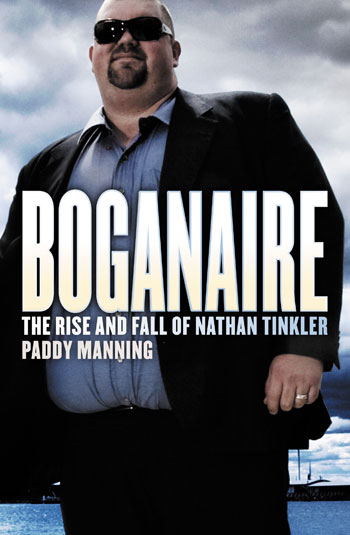
Crikey‘s Paddy Manning has a new book out, Boganaire: The Rise and Fall of Nathan Tinkler. Here’s a brief except:
Nathan Tinkler had a stunning fall from grace. Tinkler had debuted on the BRW Rich List with $426 million in 2008, at the age of 32, and peaked at $1.1 billion at the age of 35 (although, in retrospect, there is no way this was an accurate estimate of his net wealth in September 2011). Two years later, his fortune was gone.
…A former Hunter Valley mine electrician, Tinkler borrowed big in 2005, made a fortune from speculative coal plays, and at the age of just 35 burst onto the Rich List as Australia’s youngest billionaire. But Tinkler’s business model only worked in a rising market, and when coal prices slumped in 2012, he had no cash flow to service his huge debts. Within months he was trying desperately to stave off his creditors and, eventually, wound up in court.
…On the Thursday morning, March 14, 2013, the Supreme Court was packed to bursting. For the next day and a half, Tinkler played nice as he was grilled by the liquidator’s barrister, Robert Newlinds SC. Softly spoken and asserting legal “privilege” before every answer to avoid incriminating himself, Tinkler could not have been more helpful — except that his whole argument was based on one-sided recollections of undocumented conversations.
Newlinds grilled him about his personal finances to determine whether he could pay any judgement against him. Tinkler declared a taxable income of just $9834 in 2010-11, mainly interest from various bank accounts. Once again, a billionaire was revealed to be paying no tax at all.
Apart from a farm in Port Macquarie worth about $700,000, no assets were in Tinkler’s name — no other real estate, no cars, no stocks or bonds. Tinkler had a couple of joint bank accounts with his wife that had roughly a quarter of a million dollars in them. That was it.
Tinkler got all his spending money by way of tax-free distributions from a unit trust controlled by his wife, Rebecca, as the unit holder and trustee. He identified it as the Tinkler Group Family Trust. Created in 2007, it had sold his shares in Macarthur Coal and had paid around $100 million in tax. But Tinkler had no idea how much money he’d taken out of the trust in 2010-11.
…This got a laugh: Tinkler was charming the room, playing dumb. It was understandable that he might be foggy about the details, but when he was asked to describe the assets and liabilities of his wife’s trust, Tinkler departed from credibility.
On oath, Tinkler said the total amount of assets in his wife’s trust was “around $1.4 billion”. When asked what was in the trust, apart from his 19% take on Whitehaven stake — worth roughly $600 million at $3 a share — Tinkler identified Aston Metals, Hunter Ports and Hunter Rail, and his Patinack Farm stud, which he reckoned was worth “at least” $100 million after debt.
To anybody who knew these assets, the valuation was laughable. Aston Metals was worth $50 million, tops. Hunter Ports and Hunter Rail were failed infrastructure projects, all but worthless. Patinack Farm was heavily encumbered and had twice been put on the market. With Whitehaven’s shares in the toilet, there was no way the collection of assets Tinkler identified was worth anything like $1.4 billion.

